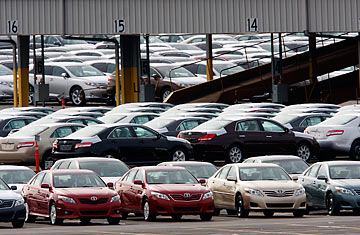
Toyota Camrys and Avalons sit ready to be shipped at the company's manufacturing plant in Georgetown, Ky.
(2 of 2)
April 2008–January 2009: Another investigation, regarding the Sienna, overlaps with the Tacoma petition review for four months. This one gets bumped up to an engineering analysis, which leads to a recall of Siennas. In the event that the clip securing the floor-carpet cover is missing, the NHTSA report reads, the accelerator pedal can become stuck. It is the same problem that had been noticed and dismissed by Toyota in 2003.
April 2009: The NHTSA receives another petition, this one to investigate throttle-control problems unrelated to floor-mat issues in Lexus ES vehicles.
August 2009: An off-duty highway patrolman and his family are killed when they rent a Lexus ES350 and have a runaway crash. The NHTSA and the California Highway Patrol investigate the incident and believe the floor mat snagged the pedal, causing the uncontrollable acceleration.
October 2009: Toyota recalls 3.8 million vehicles on the grounds that floor mats can trap the pedals. Despite reportedly suspecting problems with pedal design following the Lexus crash, the NHTSA denies the petition made in April; in its report, the administration says "the only defect trend" is the floor-mat problem, and since Toyota already issued a recall, the "contentions that any further investigation is necessary are unsupported."
November 2009: Toyota publicly apologizes to the NHTSA after reporting that the administration found that "no defect exists." Even when closing the book on a complaint, the NHTSA includes a disclaimer in each report explaining that its determination not to look into an issue doesn't constitute a finding that there's definitely no safety-related defect.
December 2009: NHTSA officials go to Japan to discuss the recall process. A press release from Secretary of Transportation Ray LaHood's office states that the "NHTSA indicates that it expects improvement in [Toyota's] responsiveness in the future."
Jan. 16, 2010: Toyota informs the NHTSA that the pedals themselves have a dangerous "sticky" habit. It's not just the floor mats, after all.
Jan. 19, 2010: The NHTSA meets with Toyota in Washington to discuss the sticking-pedal business, and Toyota calls the administration later that day to announce its plans for a wider recall.
Jan. 21, 2010: Toyota recalls approximately 2.3 million more vehicles because of sticking pedals.
Jan. 26, 2010: Toyota stops selling eight models as part of the recall, which leads to thousands of losses in unit sales.
Jan. 27, 2010: Toyota announces the recall of an additional 1.1 million vehicles because of pedal-entrapment problems.
Feb. 3, 2010: Toyota announces worries about brakes in Prius models. As of Feb. 4, 458 complaints would be filed on the NHTSA's website regarding the 2010 Toyota Prius. By Feb. 8, there would be 1,310 complaints. (The 2010 Honda Insight, by comparison, has just two.)
Also on this day, Secretary LaHood lets slip instructions for Toyota owners to "stop driving." He later says he misspoke, but not before Toyota's stock takes a blow. He also says the government had to pressure Toyota before the company would take care of the recall-related problems.
Feb. 4, 2010: Toyota announces antilock problems as the source of brake issues with the Prius.
Feb. 9, 2010: Toyota announces that it will recall 437,000 hybrid cars worldwide, including the Prius, the Prius Plug-In Hybrid, the Sai and the Lexus HS250h, to fix a problem with the brake systems. Toyota executives suggest that the recall is voluntary.
Feb. 10, 2010: Toyota's North American president, Yoshi Inaba, is set to testify with other company bigwigs about Toyota's safety record at a House Oversight and Government Reform Committee hearing. LaHood has said civil penalties are a strong possibility.
